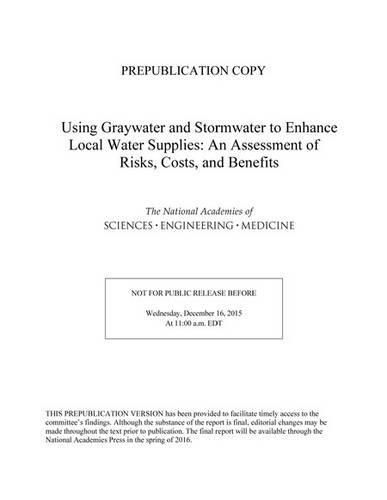Readings Newsletter
Become a Readings Member to make your shopping experience even easier.
Sign in or sign up for free!
You’re not far away from qualifying for FREE standard shipping within Australia
You’ve qualified for FREE standard shipping within Australia
The cart is loading…






Chronic and episodic water shortages are becoming common in many regions of the United States, and population growth in water-scarce regions further compounds the challenges. Increasingly, alternative water sources such as graywater-untreated wastewater that does not include water from the toilet but generally includes water from bathroom sinks, showers, bathtubs, clothes washers, and laundry sinks- and stormwater-water from rainfall or snow that can be measured downstream in a pipe, culvert, or stream shortly after the precipitation event-are being viewed as resources to supplement scarce water supplies rather than as waste to be discharged as rapidly as possible. Graywater and stormwater can serve a range of non-potable uses, including irrigation, toilet flushing, washing, and cooling, although treatment may be needed. Stormwater may also be used to recharge groundwater, which may ultimately be tapped for potable use. In addition to providing additional sources of local water supply, harvesting stormwater has many potential benefits, including energy savings, pollution prevention, and reducing the impacts of urban development on urban streams. Similarly, the reuse of graywater can enhance water supply reliability and extend the capacity of existing wastewater systems in growing cities.
Despite the benefits of using local alternative water sources to address water demands, many questions remain that have limited the broader application of graywater and stormwater capture and use. In particular, limited information is available on the costs, benefits, and risks of these projects, and beyond the simplest applications many state and local public health agencies have not developed regulatory frameworks for full use of these local water resources.
To address these issues, Using Graywater and Stormwater to Enhance Local Water Supplies analyzes the risks, costs, and benefits on various uses of graywater and stormwater. This report examines technical, economic, regulatory, and social issues associated with graywater and stormwater capture for a range of uses, including non-potable urban uses, irrigation, and groundwater recharge. Using Graywater and Stormwater to Enhance Local Water Supplies considers the quality and suitability of water for reuse, treatment and storage technologies, and human health and environmental risks of water reuse. The findings and recommendations of this report will be valuable for water managers, citizens of states under a current drought, and local and state health and environmental agencies.
$9.00 standard shipping within Australia
FREE standard shipping within Australia for orders over $100.00
Express & International shipping calculated at checkout
Chronic and episodic water shortages are becoming common in many regions of the United States, and population growth in water-scarce regions further compounds the challenges. Increasingly, alternative water sources such as graywater-untreated wastewater that does not include water from the toilet but generally includes water from bathroom sinks, showers, bathtubs, clothes washers, and laundry sinks- and stormwater-water from rainfall or snow that can be measured downstream in a pipe, culvert, or stream shortly after the precipitation event-are being viewed as resources to supplement scarce water supplies rather than as waste to be discharged as rapidly as possible. Graywater and stormwater can serve a range of non-potable uses, including irrigation, toilet flushing, washing, and cooling, although treatment may be needed. Stormwater may also be used to recharge groundwater, which may ultimately be tapped for potable use. In addition to providing additional sources of local water supply, harvesting stormwater has many potential benefits, including energy savings, pollution prevention, and reducing the impacts of urban development on urban streams. Similarly, the reuse of graywater can enhance water supply reliability and extend the capacity of existing wastewater systems in growing cities.
Despite the benefits of using local alternative water sources to address water demands, many questions remain that have limited the broader application of graywater and stormwater capture and use. In particular, limited information is available on the costs, benefits, and risks of these projects, and beyond the simplest applications many state and local public health agencies have not developed regulatory frameworks for full use of these local water resources.
To address these issues, Using Graywater and Stormwater to Enhance Local Water Supplies analyzes the risks, costs, and benefits on various uses of graywater and stormwater. This report examines technical, economic, regulatory, and social issues associated with graywater and stormwater capture for a range of uses, including non-potable urban uses, irrigation, and groundwater recharge. Using Graywater and Stormwater to Enhance Local Water Supplies considers the quality and suitability of water for reuse, treatment and storage technologies, and human health and environmental risks of water reuse. The findings and recommendations of this report will be valuable for water managers, citizens of states under a current drought, and local and state health and environmental agencies.